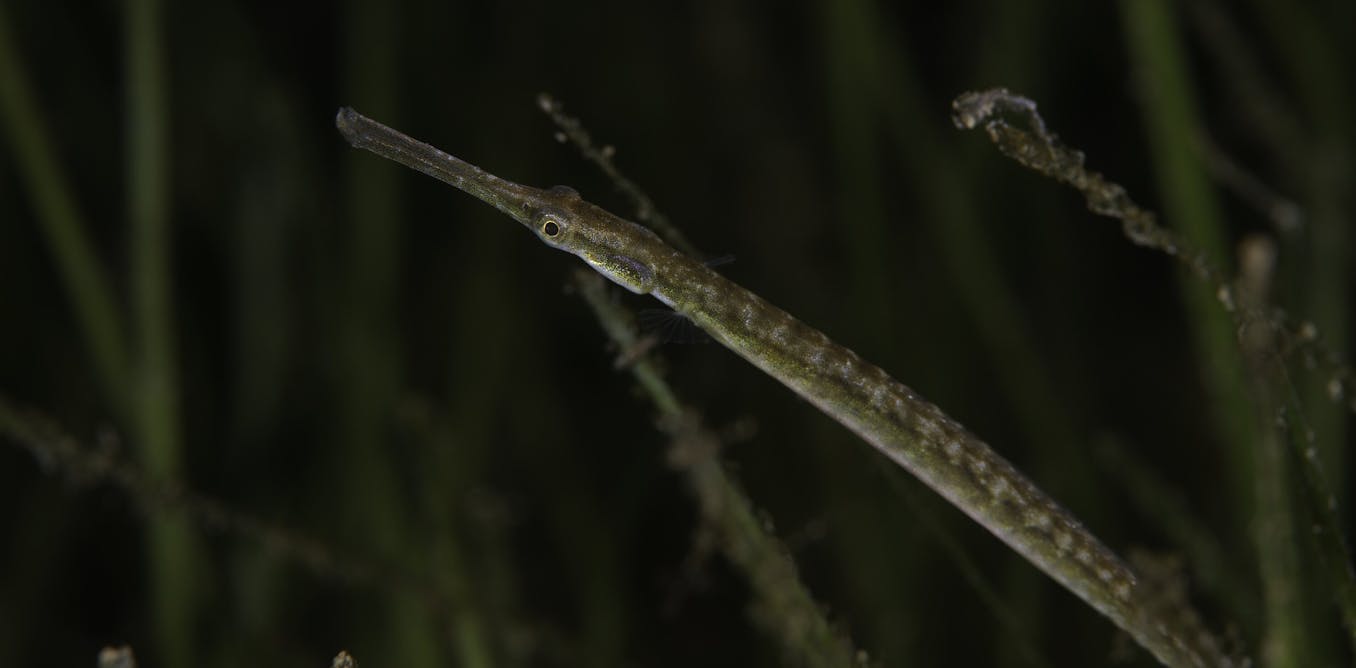
- Select a language for the TTS:
- UK English Female
- UK English Male
- US English Female
- US English Male
- Australian Female
- Australian Male
- Language selected: (auto detect) - EN
Play all audios:
If you’ve ever watched a natural history programme on TV, you’ve probably seen animals performing a wide variety of behaviours to get the attention of the opposite sex. BBC Earth even
released an interview with David Attenborough about some of nature’s most spectacular mating displays. Not included, however, was Aotearoa New Zealand’s wide-bodied pipefish – although I
think they should have been! As our recent research explains, our local pipefish species really does confound expectations. Pipefish are unusual because the males carry their developing
babies around on their bodies, often in special broad pouches. In some species, these pouches are the only difference in appearance between males and females. But that’s not the case for New
Zealand’s wide-bodied pipefish. Females have a torso that can be almost three times as wide as males, and they have brightly coloured stripes. Why females have such a different body shape
is a mystery. We set out to solve the puzzle by observing how females use this trait when interacting with other females and with males. To do this, we brought wild fish into aquariums and
filmed their behaviours in groups of males and females. THE SURPRISING COURTSHIP We found males initiated courtship displays with females most of the time, using comical wiggles. This was
unexpected because the wide-bodied pipefish gets its name from the broad, colourful, striped abdomen of the female – not the male. Given this ornamentation, we expected females would
approach males for courtship and display more often and for longer than males. Normally, the sex with more ornamentation in a species will lead the courtship display.
------------------------- _ READ MORE: DNA IN THE WATER SHOWS SOUTH AFRICAN SCIENTISTS WHERE TO FIND A RARE PIPEFISH _ ------------------------- But what we observed was surprising. Often, a
group of male wide-bodied pipefish would wiggle at a single female. These males would sometimes follow the female around the tank if she swam away. The resulting bouts of courtship display
could last for minutes on end. The results suggest males are more active in making decisions about who they want to court than has been described in other pipefish species. Our findings also
mean we can’t necessarily predict which sex will be most active in courtship based on their ornamental traits and the differences in shape between males and females. THE PREGNANT MALE
Wide-bodied pipefish – like their close relatives seahorses – also feature male pregnancy. So males put a lot of energy into caring for their developing embryos. One possible reason the
males are so active in courtship is that they are choosing the most fecund females – those with the most available eggs. Females deposit eggs into the male’s pouch, making him pregnant, and
he fertilises those eggs and then cares for the embryos as they develop. Females who can give the male more eggs might therefore be preferred by males. These findings differ from what we
know about pipefish species in other parts of the world. All pipefish have the unusual male pregnancy capability. But usually females initiate courtship, and males reject some females. Any
group behaviours involve more females than males. So even among pipefish, the wide-bodied pipefish is particularly odd. ------------------------- _ READ MORE: TINY AND MYSTERIOUS: RESEARCH
SHEDS LIGHT ON SUB-SAHARAN AFRICA’S SEAHORSES, PIPEFISH AND PIPEHORSES _ ------------------------- Our research is the first step in understanding how wide-bodied pipefish males and females
interact, and it’s raised more questions for us to answer. We now want to know whether males court females in groups when there are more females than males, and vice versa. Knowing more
about these unusual fish behaviours is important in the broader context of mating behaviours scientists are already aware of. Having a diversity of examples can help make sense of unexpected
behaviours in other species – and can challenge our expectations of the world. There is still so much to learn, but every additional piece of the puzzle helps us understand what influences
the weird and wonderful animals living around us. ------------------------- _All of the research described was approved by the University of Canterbury’s Animal Ethics Committee._
-------------------------









:max_bytes(150000):strip_icc():focal(319x0:321x2)/people_social_image-60e0c8af9eb14624a5b55f2c29dbe25b.png)